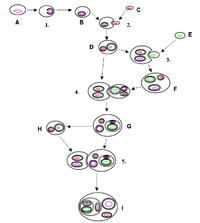
Main article: Endosymbiotic theory

Some of the pathways by which the various endosymbionts might have arisen.
Modern taxonomy classifies life into three domains. The time of the origin of these domains is uncertain. The Bacteria domain probably first split off from the other forms of life (sometimes called Neomura), but this supposition is controversial. Soon after this, by 2 Ga,
[42] the Neomura split into the Archaea and the Eukarya. Eukaryotic cells (Eukarya) are larger and more complex than prokaryotic cells (Bacteria and Archaea), and the origin of that complexity is only now becoming known.
Around this time, the first proto-mitochondrion was formed. A bacterial cell related to today’s
Rickettsia,
[43] which had evolved to metabolize oxygen, entered a larger prokaryotic cell, which lacked that capability. Perhaps the large cell attempted to ingest the smaller one but failed (possibly due to the evolution of prey defenses). The smaller cell may have tried to parasitize the larger one. In any case, the smaller cell survived inside the larger cell. Using oxygen, it metabolized the larger cell’s waste products and derived more energy. Some of this excess energy was returned to the host. The smaller cell replicated inside the larger one. Soon, a stable symbiosis developed between the large cell and the smaller cells inside it. Over time, the host cell acquired some of the genes of the smaller cells, and the two kinds became dependent on each other: the larger cell could not survive without the energy produced by the smaller ones, and these in turn could not survive without the raw materials provided by the larger cell. The whole cell is now considered a single organism, and the smaller cells are classified as organelles called mitochondria.
A similar event occurred with photosynthetic cyanobacteria
[44] entering large heterotrophic cells and becoming chloroplasts.
[34]:60-61[31]:536-539 Probably as a result of these changes, a line of cells capable of photosynthesis split off from the other eukaryotes more than 1 billion years ago. There were probably several such inclusion events, as the figure at right suggests. Besides the well-established endosymbiotic theory of the cellular origin of mitochondria and chloroplasts, it has been suggested that cells led to peroxisomes, spirochetes led to cilia and flagella, and that perhaps a DNA virus led to the cell nucleus,
though none of these theories is widely accepted.
[47]

Green algae of the genus
Volvox are believed to be similar to the first multicellular plants.
Archaeans, bacteria, and eukaryotes continued to diversify and to become more complex and better adapted to their environments. Each domain repeatedly split into multiple lineages, although little is known about the history of the archaea and bacteria. Around 1.1 Ga, the supercontinent Rodinia was assembling.
[48] The plant, animal, and fungi lines had all split, though they still existed as solitary cells. Some of these lived in colonies, and gradually some division of labor began to take place; for instance, cells on the periphery might have started to assume different roles from those in the interior. Although the division between a colony with specialized cells and a multicellular organism is not always clear, around 1 billion years ago
[49] the first multicellular plants emerged, probably green algae.
[50] Possibly by around 900 Ma
[31]:488 true multicellularity had also evolved in animals.
At first it probably resembled today’s sponges, which have totipotent cells that allow a disrupted organism to reassemble itself.
[31]:483-487 As the division of labor was completed in all lines of multicellular organisms, cells became more specialized and more dependent on each other; isolated cells would die.
